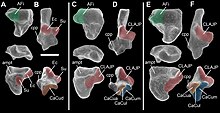| Djarthia Temporal range: Early Eocene
| |
|---|---|

| |
| Isolated petrosals of Djarthia murgonensis | |
| Scientific classification | |
| Domain: | Eukaryota |
| Kingdom: | Animalia |
| Phylum: | Chordata |
| Class: | Mammalia |
| Infraclass: | Marsupialia |
| Superorder: | Australidelphia |
| Genus: | †Djarthia Godthelp et al., 1999 |
| Species: | †D. murgonensis
|
| Binomial name | |
| †Djarthia murgonensis Godthelp, et al, 1999
| |

Djarthia is an extinct monotypic genus of marsupial. It is the oldest marsupial found in Australia, discovered at the Murgon fossil site in south-eastern Queensland.
D. murgonensis was described from material identified as Early Eocene Tingamarran fauna, first published in 1999.[1] It was placed with the clade Australidelphia, which includes the marsupials that dispersed throughout Eastern Gondwanan supercontinent during the Eocene and remain extant in Australia and South America. Skeletal material described include a molar, incomplete cochlear and tarsal bone either complete or in fragmented state of preservation.[2]
References
[edit]- ^ Godthelp, Henk; Wroe, Stephen & Archer, Michael (1999). "A New Marsupial from the Early Eocene Tingamarra Local Fauna of Murgon, Southeastern Queensland: A Prototypical Australian Marsupial?". Journal of Mammalian Evolution. 6 (3): 289–313. doi:10.1023/A:1020517808869. ISSN 1573-7055. S2CID 39325291.
- ^ Beck, Robin M. D.; Godthelp, Henk; Weisbecker, Vera; Archer, Michael & Hand, Suzanne J. (2008). "Australia's Oldest Marsupial Fossils and their Biogeographical Implications". PLoS ONE. 3 (3). Public Library of Science: e1858. Bibcode:2008PLoSO...3.1858B. doi:10.1371/journal.pone.0001858. PMC 2267999. PMID 18365013.
Well, that’s interesting to know that Psilotum nudum are known as whisk ferns. Psilotum nudum is the commoner species of the two. While the P. flaccidum is a rare species and is found in the tropical islands. Both the species are usually epiphytic in habit and grow upon tree ferns. These species may also be terrestrial and grow in humus or in the crevices of the rocks.
View the detailed Guide of Psilotum nudum: Detailed Study Of Psilotum Nudum (Whisk Fern), Classification, Anatomy, Reproduction